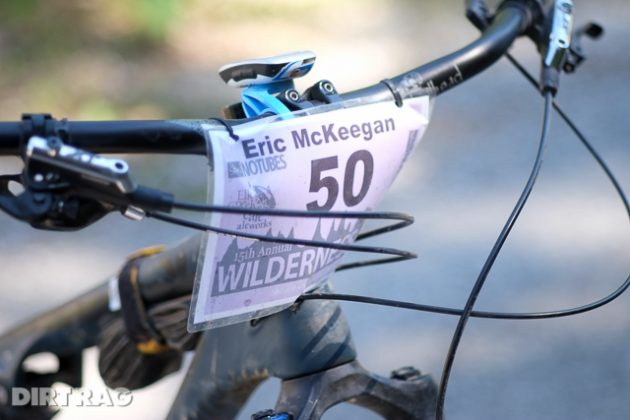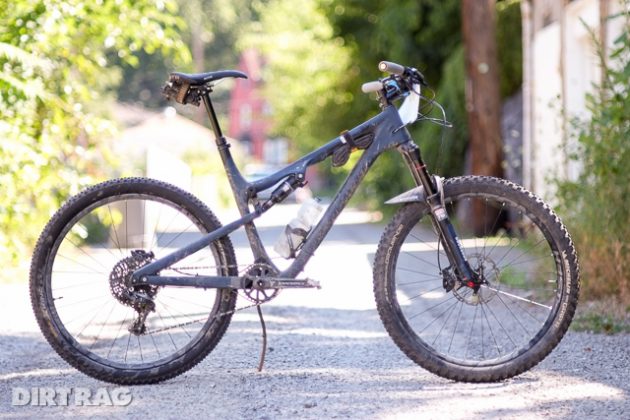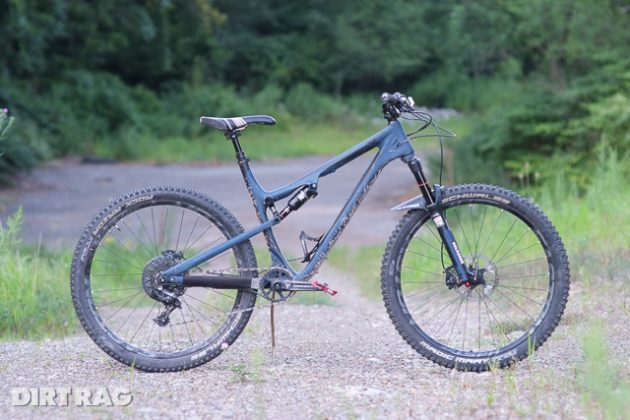The One-Bike Challenge
Originally posted on November 24, 2015 at 7:00 amRocky Mountain Thunderbolt 790 MSL BC Edition
How far can a short-travel trail bike take you? From Issue #187
We are at an interesting point in the technological advances in mountain bikes. For years the idea was always more. More travel, more gears, more bigger wheels. But now we’ve started to dial things back: Single ring drivetrains, 27.5 wheels, shorter travel trail bikes, gravity riders dumping full blown downhill racers for 160 mm trail bikes that can climb.
With scenes of “Top Gear”, “Road Kill” and “Junkyard Wars” challenges floating in my head, the One Bike Challenge was conceived. Could a spoiled bike media guy be happy on one bike for three very different big events? Would I have fun? Would I spend the whole time thinking about bikes I’d rather be riding? Would I decide to give up riding for water polo? Let’s see what happens.

The Events
Bikepacking: A self-contained bikepacking trip in Pennsylvania on a mix of pavement, dirt roads and technical singletrack
Endurance: The Wilderness 101, a brutal 100-mile race with 10,000 feet of climbing and rocks everywhere in central Pennsylvania
Gravity: Chomolungma Challenge, a 20-lap downhill race at Snowshoe bike park in West Virginia, totaling 30,000 feet of descending

The Bike: Rocky Mountain Thunderbolt 790 MSL BC Edition
Almost all the bikes on the shortlist were in the 120 to 130 mm travel range, and all were 29ers. My logic? Since the bikepacking and endurance segments of this challenge would be where the majority of my saddle time would take place, the larger wheels have been my go to for that type of stuff for over a decade now. Also, bigger wheels can help make up for shorter travel when things get fast and chunky.
Slowly, each of my initial selections were crossed of the list for various reasons. Some brands were about introduce an improved model that wouldn’t be ready in time. Some were so popular companies prioritized dealers and consumers over media when bikes were scarce. Some never bothered to return my calls or emails.
So I cast a wider net and started to consider the wide range of 27.5 wheeled bikes. It didn’t take long to hone in on the Thunderbolt in B.C. Edition trim. Strong wheels, Pike fork, adjustable geometry. Rocky Mountian was agreeable to the challenge, and I was in business.
Rocky’s BC Edition moniker refers to hot-rodded versions of existing bikes based on employees’ customization of stock bikes to make them more capable on the famous trails in British Columbia. The stock Thunderbolt is a capable 120 mm trail bike, and the BC Edition drops in a 130 mm RockShox Pike fork, NoTubes Flow wheelset, 2.4-inch Maxxis Ardent EXO-casing tires, a wider bar/shorter stem and single-ring drivetrain.
Full disclosure: I did swap the wheels out for a set of the new Easton Heist 27.5 wheels, and the RockShox Reverb dropper post for a 9Point8 Fall Line dropper. Since both the stock wheelset and dropper are so well proven, I took the opportunity to test some new products.
Rocky utilizes its Smoothlink suspension design for the Thunderbolt (and all other full-suspension bikes in its lineup). Smoothlink is a four-bar system with the pivot above the rear axle, rather than below in Horst-link style. The Thunderbolt uses a full complement of bushings (not ball-bearings) at all pivots. A new collet system keeps the main pivot tight, and grease ports all-around keep maintenance time at a minimum.
Its Ride-9 System adjusts both geometry and suspension progression. With nine different settings, this is a tinker’s dream or a Luddite’s nightmare. I think most riders will either leave it where the shop sets it or experiment until a favorite setting is found and not touch it again.
The frame is fully carbon, with internal routing for the dropper and derailleur cables, and the rear brake hose is external.
Bikepacking
Since I have hand-pain issues on long days, I swapped out the stock 760 mm bars for some 28-degree Fouriers Trailhead alt-bars and a longer stem. I installed lighter tires and a thicker WTB Vigo saddle, along with bags from Carousel Design Works, Blackburn and Porcelain Rocket to carry my gear. I really wanted to retain the use of my dropper post, so I strapped a Thule Pack ’n Pedal rack to the seatstays, leaving plenty of room for the seat to drop. I set the suspension in the middle setting, figuring the most neutral handling would be the best for bikepacking.

My trip was a loosely planned route that covered a lot of rarely used logging/fracking roads, rocky hiking trails and plenty of paved back roads. The trip started with a steady four-mile paved climb where I appreciated the firmest Lock setting on the RockShox Monarch RT3 Debonair shock.
The voyage was surprisingly without much fanfare, and this trail bike handled it all with surprising grace. Pedal mode on both the shock and fork helped to control the additional sprung weight added by the camping gear.
I really wasn’t expecting the ride-all-day comfort provided by the Thunderbolt, but it delivered with a combination of efficient pedaling, comfortable geometry and a playful attitude. The ride ended with a descent down that same four-mile climb, and even with bags I was able to relax on the bike; there was no weird shimmy, headshake or wobble from the front end. In fact, I was able to ride no-handed at speeds well over 20 mph, something rare even on dedicated touring rigs.
Endurance
The Wilderness 101 is a very hard race. And I didn’t find the time to do much training. By the time I hit mile 40, I was spent. But even after I was offered a friendly ride back to camp from aid station 3, I decided to continue. I had an article to write, and dropping out was less interesting that sticking to it. I downed handfuls of whatever looked tasty at the aid station and walked up the next hill (and many more after that), but I finished.
I lowered the stem by 10 mm and swapped to a WTB Volt saddle, other than that, my endurance setup was the same as bikepacking, minus the bags. I had cross-country tires to install, but after much frustration, I realized they weren’t tubeless and gave up and reinstalled the sturdy, but slow-rolling combo I used for bikepacking.

On the many miles of dirt roads, the Thunderbolt was very efficient, although I missed the way 29er wheels roll on the road, particularly when trying to hang on to the back of a paceline. In the rocks the nimble geometry was a blast; the steeper the decent, the happier I was.
This event was where the Thunderbolt felt most at home to me, which isn’t surprising, as the 101 is very much like a typical mountain-bike ride, just longer.
Gravity
I took on the Chomolungma Challenge a few years ago, but that was on a real downhill bike. This was the event I was most worried about. A few bad choices here can mean a few months off the bike.
Due to deadline timing, I wasn’t able to take part in the actual race, but I did my best to reenact the conditions. After a warm up lap on each of the two tracks used for the event on a 160 mm bike, I then dropped in on the Thunderbolt. After a few laps of the Pro downhill track, I think I realized what makes the Thunderbolt such a great bike: It’s up for almost anything, including laps of a real downhill track. Good tires helped with this, and the Schwalbe Muddy Mary and Rock Razor with Super Gravity casings allowed me to attack the rocks with more confidence than I expected for a short travel bike.

After a few laps of the pro downhill track, I realized what makes the Thunderbolt such a great bike: It’s up for almost anything, including laps of a real downhill track. Good tires helped with this, and the Schwalbe Magic Mary and Rock Razor with Super Gravity casings allowed me to attack the rocks with more confidence than I expected for a short-travel bike.
I ran the Ride-9 chip in the slackest setting, never futzed with the suspension setting all day, and was highly impressed with the bottom-out resistance of the rear suspension.
But, unlike riding a true downhill bike, instead of dialing in the lines as the day progressed on the Pro course, I started to get sloppier and sloppier, so I swapped to the other track, which was more jumpy, but still had plenty to keep me on my toes, including a long section of baby heads that I remember as torture by the end of the race. I felt much more in control here, but after stopping for lunch, I realized I wasn’t that interested in just banging out laps to just bang out laps. Instead I hit up some of the trails on the Basin side of the mountain, and finished the day with a handful of trips down the Skyline jump trail. I came up short of a full 20 laps by about five, but I’ll was still having fun when I quit for the day, so I put this down as a success.
Changes and Adjustments
Bikepacking: I’d get a custom frame pack to get some water weight off my back. Even with a good backpack, I was uncomfortable pretty quickly with most of my food and water on my back.
Endurance: I’d be sure I was prepared with better cross-country tires. Something that rolled more quickly would have been a huge boost, even if it was mostly just mental.
Downhill: I’d find more time beforehand to tune the suspension. The Pike, which felt great on the trail, bottomed out regularly in the bike park, which coud be remedied with another Bottomless Token in the air chamber.
One-Bike Challenge Conclusion
Was it a success? Absolutely. I had a lot of fun at these events, although my idea of fun might be on the masochistic side of things for some riders. But all that aside, I was highly impressed with what this bike could do, and expect with more time and more tuning it could be even better. While having a quiver of bikes is always going to be more fun for most people, a single mountain bike these days is a hell of a tool for a variety of riding.

Thunderbolt Final Thoughts
At its core, this is a simple bike. Short travel, subdued graphics and a parts spec that is more about getting the job done than impressing your buddies at the trailhead. But dig deeper and this is one of the most versatile bikes on the market today. While setting up adjustable geometry and suspension settings can be tedious, a rider looking for specific handling characteristics, or one that falls outside the standard weight range can find a happy place here.
To me, this is almost perfect trail-bike geometry: A short rear end, longer front-center and a low-ish bottom bracket combined with a slack head angle are the key ingredients to a bike that can carve and pop and rumble. This is one of my favorite-handling bikes, ever. I love long rides on unfamiliar terrain, and that might be where this one is most at home: efficient enough to ride all day, but with enough handling in reserve to save a few bad line choices on some unexpected chutes.
What complaints I can muster are few. The rear suspension wasn’t the most plush on square-edged hits, but this is only a 120 mm rear end. The air valve is difficult reach with most shock pumps when in the slackest setting, making suspension tuning tedious. No ISCG tabs means no chainguide. On the positive front, this frame fully supports a front derailleur, the internal routing is dialed, and those grease ports on the pivots are awesome.
This review is the hardest test we’ve ever put a bike through, testing its abilities at the edges and even past its intended purposes. The Thunderbolt was part steady friend, part happy puppy and part secret lover. Whether you are after your own “one bike” or just one of the most fun and versatile trail bikes on the market, the Thunderbolt BC Edition is often just the right amount of bike for the job.
- Price: $6,400
- Sizes: XS, S, M, L (tested), XL
- More info: bikes.com